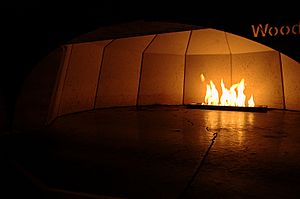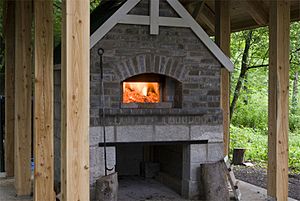Masonry oven facts for kids
A masonry oven is a special type of oven made from materials that can handle high heat. These materials include fireproof brick, concrete, stone, clay (called a clay oven), or cob (called a cob oven).
Even though these ovens traditionally burn wood, some in the 1800s used coal. Today, many modern masonry ovens use natural gas or even electricity. While they are now famous for making amazing bread and pizza, in the past, people used them for all sorts of baking. Skilled builders called masons construct these ovens.
Contents
How Masonry Ovens Started
People started building masonry ovens long before writing existed! It all began when our ancestors learned to cook with fire. They would cook food over flames or hot coals. For bigger foods like starchy roots, it worked better to bury them in hot ashes, sometimes with hot stones on top.
Large amounts of food could be cooked in an earth oven. This was a hole in the ground heated with a big fire and hot rocks. Many of these old cooking methods are still used today.
True masonry ovens, like the ones we see now, appeared when people started growing grains and making bread. Ancient Egyptians drew pictures of bakers putting dough on a hot rock and covering it with a hot clay pot. This was like the first "real" oven! Over time, these small ovens grew bigger to bake many loaves of bread. Builders started using clay pots, then brick and stone to make dome-shaped ovens.
Arabs in the Gulf States use masonry ovens to make their traditional khubz bread. In India and Pakistan, tandoors are traditional clay ovens. These are open at the top, a bit like a mix between an earth oven and a Roman-style oven. In the Americas before Europeans arrived, similar ovens were made from clay or adobe. Today, they are called horno (which means "oven" in Spanish). Hornos are still common in the American Southwest.
The classic direct-fired masonry oven is often called a "Roman" or "black" oven. It's called "black" because the fire makes soot on the oven's roof. These ovens were sometimes built for whole communities to share. They became popular in America during colonial times. Today, you'll find them in artisan bakeries, pizzerias, and even in people's backyards.
Later, "white ovens" were developed. These are heated from the outside, so the flame and soot never touch the inside walls. They are often part of a masonry heater.
Why Masonry Ovens Are Great

Masonry ovens are still popular because of how they cook food and make it taste. Regular modern ovens cook food by moving hot air around. But a masonry oven works differently. It soaks up heat like a battery charging up. Once hot, its heavy walls slowly release that heat for hours.
This means food cooks in several ways:
- By hot air.
- By radiant heat from the hot walls.
- For bread and pizza, heat goes directly into the food from the hot floor bricks. This helps bread rise extra well, which bakers call "oven spring."
Also, a masonry oven traps the steam that comes from the water in cooking food. This steamy air helps create a more flavorful and chewy crust on bread and pizza. It also keeps other foods moist and tender. This combination of heat types makes cooking faster too!
For example, real Neapolitan pizza must be cooked in a wood-burning masonry oven.
How Masonry Ovens Are Built
The way masonry ovens are built hasn't changed much over thousands of years. Whether made from mud, brick, or modern materials, an oven is basically a strong shell.
Early ovens were simply made from clay soil, often mixed with sand to stop cracking. Builders would shape the clay over a form made of sticks or sand. Once the clay was hard, they would dig out the sand or burn away the wood. Smoke would leave through the oven door, either directly outside or through a chimney above the door.
Brick ovens can also be built over forms. However, many cultures learned to build dome ovens without forms, like traditional Italian dome ovens. These are built freehand, sometimes just by looking. Each layer of bricks is set at a steeper angle, bringing the dome closer to the center. The bricks stick together with wet mortar until the top is closed with a central "keystone."
Modern ovens often include insulation. Since masonry can lose heat, early ovens were built with very thick walls to hold more heat. But modern insulation helps keep the heat inside the oven much better.
Modern Insulation
Insulation is a big change in how masonry ovens are built today. Just like a person needs a mattress and a blanket to stay warm, an oven needs insulation underneath and on top. This stops heat from escaping.
One way to slow heat loss is to build the oven off the damp ground. Some traditional ovens were even built on wood frames! Modern builders often use lightweight concrete or special insulative boards. These materials are strong but also keep heat from leaking out of the oven's base.
Some builders use a low-cost method for insulation: empty glass bottles surrounded by a mix of clay and organic materials like sawdust. As the sawdust burns away, it leaves tiny holes in the clay, making a light, foamy, and insulating material.
To keep the top of the oven warm, builders might create a space around the oven and fill it with loose insulating materials. For a smoother, rounder look, the oven can be wrapped in mineral wool blankets. These blankets are like fiberglass but can handle much higher temperatures. They need to be covered with stucco or tiles.
Experts suggest that the oven door should be about 63% of the dome's height. If the door is too high, heat escapes. If it's too low, air and smoke can't move freely, and the fire won't burn well.
Some modern masonry ovens look very different from old ones. They might just have a cast floor (like a pizza stone) inside a more regular-looking oven. These are mostly used in restaurants, but smaller versions are available for homes.
Types of Ovens
Cob, Clay, and Earth Ovens
"Cob" is a British word for a building material similar to adobe (which means "the mud" in Arabic). Earth, clay, and cob construction are popular because they use simple, natural materials. Building a wood-fired oven is a common first project for people interested in these methods.
The earliest masonry ovens, even in ancient Egypt, were usually made from local clay. This clay was often mixed with gravel, sand, or straw to prevent cracking. Smaller ovens were built over forms made of sand or stick baskets. Once the clay was hard, the sand was removed or the sticks were burned.
Ceramic Cloche
A cloche is like an upside-down ceramic bowl with a handle. It's heated in the fire along with a flat rock or a hot spot on the hearth. Then, prepared dough is placed on the hot surface and covered with the cloche. Sometimes hot coals or ashes are added on top for extra heat. This method dates back to ancient Egypt and Greece and was probably the first type of masonry oven.
Getting a Masonry Oven Effect at Home
You can get some of the benefits of a masonry oven without building a full one.
- The most common way is using a stoneware pizza stone. This stone stores heat in your regular oven and transfers it directly to the bottom of your pizza.
- Regular firebricks can be used in a similar way on an oven shelf.
- Bread and meat can be cooked in a covered ceramic dish, sometimes called a cloche or a Dutch oven. Cooking bread in a pre-heated Dutch oven with a tight lid can give great results.
- Some people even cook bread on a grill to get a similar radiant heat effect, especially for flatbreads and pizzas.



